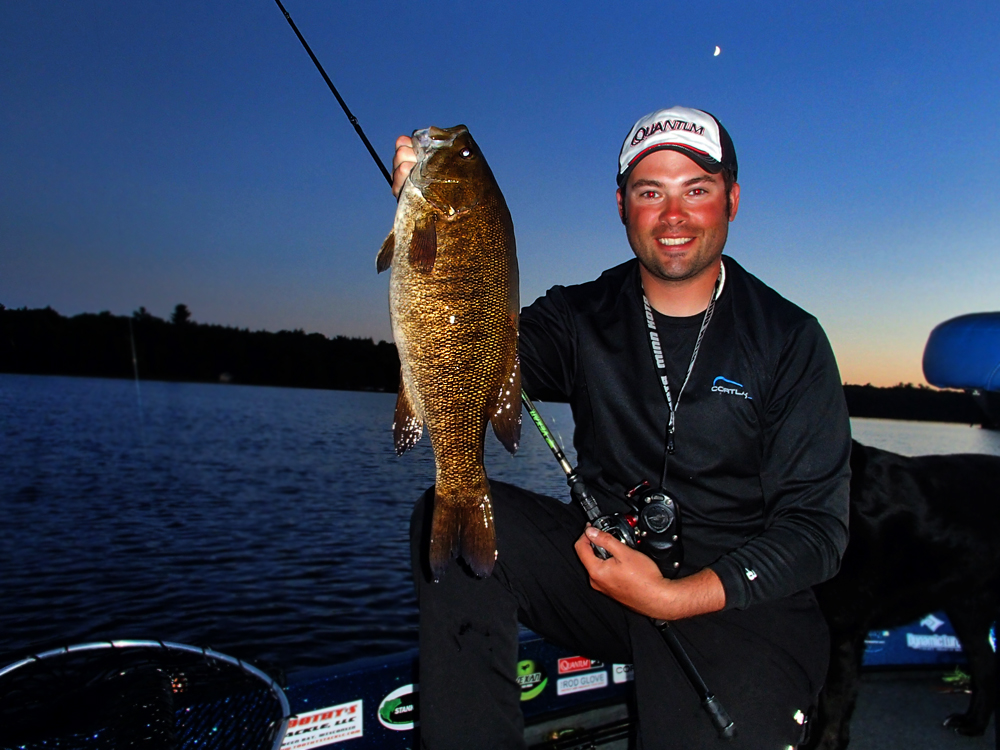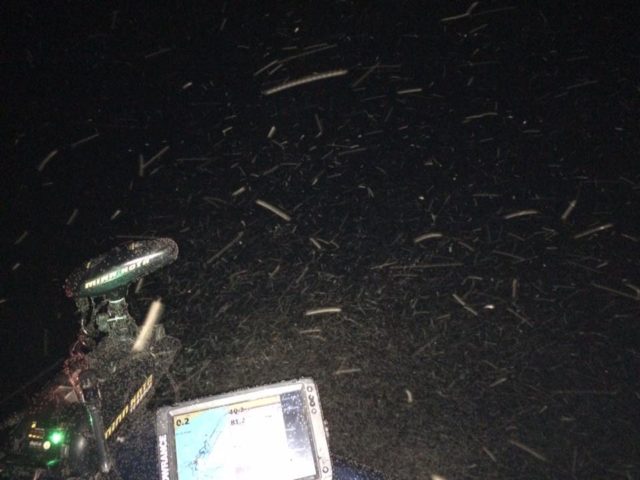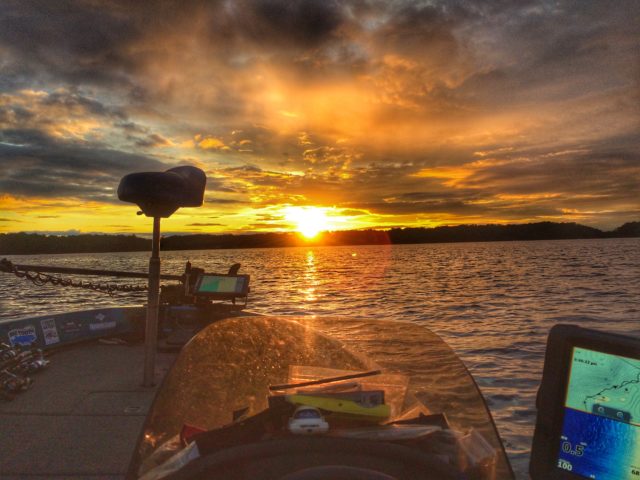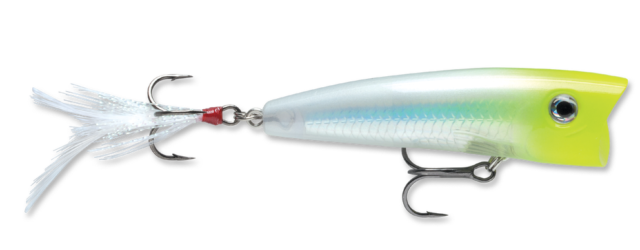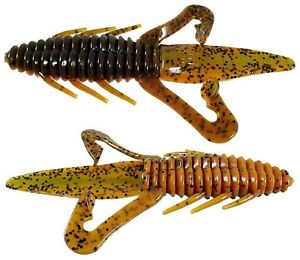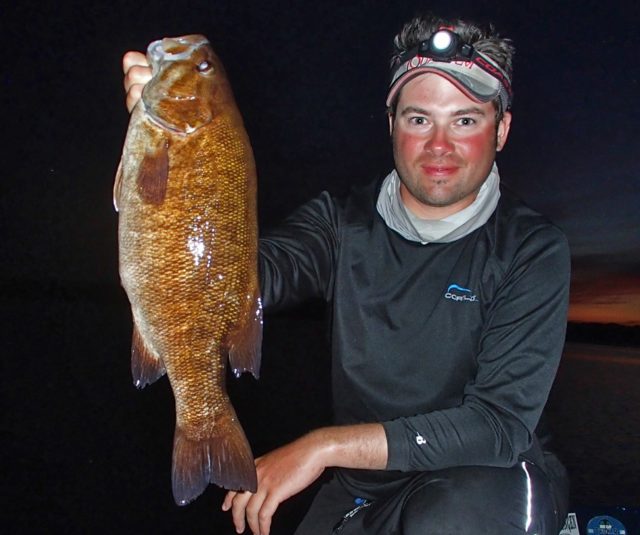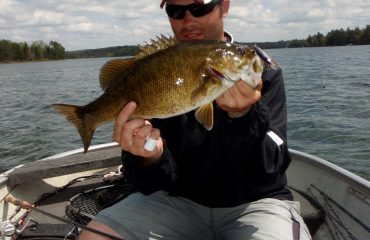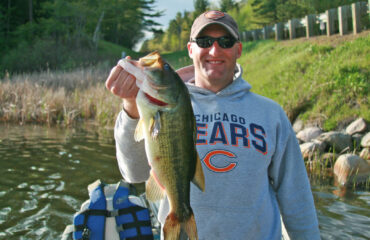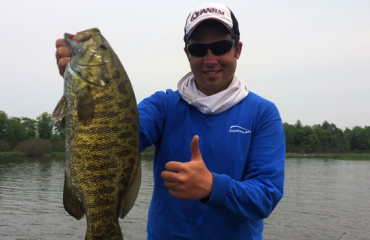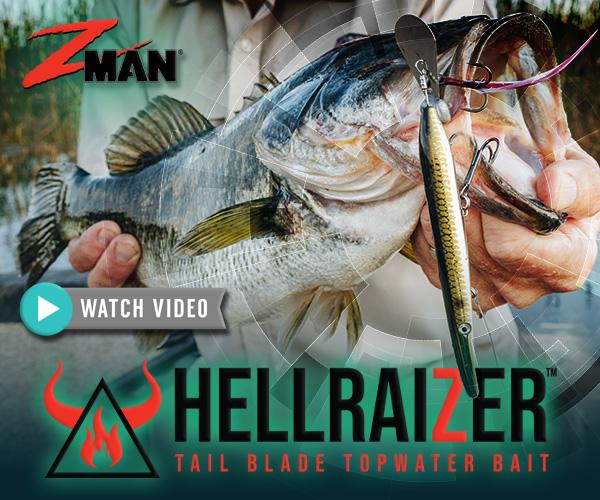The Summer Smallmouth Setup
Summer’s swelter is notorious for delivering the most difficult fishing of the season. Bites are typically less aggressive and fish are driven deep during daytime, becoming even more difficult to locate. Dog days, hot weather, warm water temperatures, heavy pleasure boat traffic and passive bites become common excuses for a poor day of fishing. Oppositely for me, these conditions deliver the best trophy smallmouth fishing of the year.
During the dog days of summer, I live for catching some of the largest and heaviest smallmouth bass of the season. Almost every night between end of July through August, from dusk till hours after dark, I work a “milkshake express” run on a handful of different bass waters. This is no ordinary milk run. This run and gun approach of thoroughly, efficiently working all known high-percentage feeding locations of the lake is strategically coordinated according to the timeline of sunset, and predictability of bass movements centered on prime habitats and feeding locations. As a result, my best and most aggressive bass bites of the season happen.
Nearly 5 seasons have passed since I first examined and revealed my night fishing observations and experiences in article format. Since then, I have experienced the same quality of fishing on all of my lakes where my night fishing practice is employed.
Like clockwork, the consistency of warm stable weather influences this pattern. What makes the success ultimately happen is my ability to track and anticipate smallmouth movements from their deep midday depths into the nighttime shallows. As the sun sets deeper into the horizon, fish will move shallower. Additionally consistency leads to predictability, therefore the presence of smallmouth on prime feeding locations is to be expected every night.
Almost half a decade later, I still have the entire lake all to myself past 9 pm besides the few walleye boats and occasional open water trollers. As the sun sets, all other boats pack it up for the night. My game only starts then.
Night Fishing Premise
Lasting anywhere from four to six weeks, depending upon region and climates, I’ve observed more big bass feeding at night rather than daytime. Triggering this feed are consecutive warm, humid, windless nights with air temperatures warmer than 70 degrees, and water temperatures holding steady at 75 and above.
This time of year, surface temperatures on most lakes can peak in the 80 degree range during daytime. Water temperature is at its seasonal peak, and can be sometimes warmer than bath water. As sunlight radiates the water, smallmouth become finicky and irresponsive, they are driven deeper to seek cooler water. While temporarily seeking sanctuary from the heat, they will eventually return again to the shallows each evening as the sun’s penetration lessens, and surface temperatures begin to cool off for the night. Fish don’t stop biting. This temporary shift in location and return to the shallows only makes them feed more.
Heat, humidity, and windless conditions speak extreme difficulty to anglers. While this can be the case for daytime fishing, it’s the preferred nighttime fishing ingredient. The hotter, humid, and more windless it is, the more aggressive smallmouth will feed.
The dog days of summer triggers a late night feeding binge. As the sun sets, smallmouth re-appear in the shallows again. Returning from their deep midday sanctuaries, they will set up along the perimeter of shallow near-shore shoals and rock bars in search for prey. On every lake I night fish, smallmouth undertake this short-distance movement to feast on the abundance of rusty crayfish, unsuspecting preyfish, and insect hatches.
Heat affects the entire ecosystem, and stalls its daytime activity. Correspondingly, heat affects anglers too, reducing our energy levels and potentially limiting our motivation to fish and withstand it. When it dissipates and relief comes, all life forms impacted by it reactivate. Peak feeding takes place. This will lead to an explosion of crayfish scavenging the shallows, and perhaps an after-dark insect or nymph hatch. All organisms in their peak activity for the day then trigger a smallmouth feeding frenzy.
Each afternoon and evening when I launch the boat, I pay attention to whether I see hundreds of crayfish scurrying across the plank. If I witness a crayfish explosion in the shallows, I know I’m in for a good night of fishing.
The Summer Set-Up is Clockwork
By this time of season, many adult smallmouth have certainly seen lots of presentations. Some, on most pressured waters, have also been caught and released a handful of times too. Metabolism is high, and warm water drives their hunger. Fish are at their peak efficiency of feeding more each day. Prey options abound, more than at any other point in the year.
Most anglers would prefer to fish at dawn and conclude by late morning. What I’ve learned over the years is that an early bird who gets the worm won’t reap the rewards like my evening schedule does. While employing an early-riser mentality can lead to success early in the day, late nights and heavier nighttime feeding make the early-riser schedule impractical. You will catch more bigger bass at night.
To succeed for this bite, I base all of my activity and fishing location around the sun’s position. Smallmouth also behave the same way as we do, as their depth and locations will also be influenced by its heat and location.
4:00 pm –
It’s the time of day you should be traveling to the lake, or at least getting ready to. In case you haven’t yet, prepare and equip yourself for night fishing. You have ample time to rig the rods, eat an early dinner, and pack trip essentials. Depending on your location, sunset hours may vary. In my neck of the woods, sunset doesn’t take place until between 8:45 pm and 9:15 pm. Until then, lots of time remains until the smallmouth onslaught.
As soon as you arrive to the boat launch and unload, be on the lookout for crayfish. They love to scavenge the concrete planks for dead minnows and bait anglers might have disposed earlier in the day. Their presence is the best indicator for active smallmouth feeding later on.
If I have nighttime fishing experience on the lake, I will proceed to fish under normal circumstances, which could consist of deep cranking, jigging, and drop shotting. I’ll probably catch some fish immediately, depending on their mood, but it will be nowhere near peak feeding activity. Meanwhile, if the lake I am fishing hasn’t been fished previously, or I have unfamiliarity with it, I begin my outing scouting it. I won’t fish until I’ve explored it.
As this timeframe is the tail end of the day when heat and sun is at its worst, it’s the best time to chart and scan the lake bottom. Before every night fishing trip, use this valuable, least productive fishing time to identify the probable lake locations and spots smallmouth will feed at. These spots will each be fished later. While doing so, confirm the presence of fish with side imaging. Pay attention to ideal shallower bottom such as boulder, rock and wood within your area too. During this timeframe, smallmouth are likely to be holding along the edges of drop offs and ledges in depths of 15 to 20 ft. As you idle through and quickly learn the water, you will mark waypoints on the after dark locations you will fish. You will also re-use those trails again for your navigation.
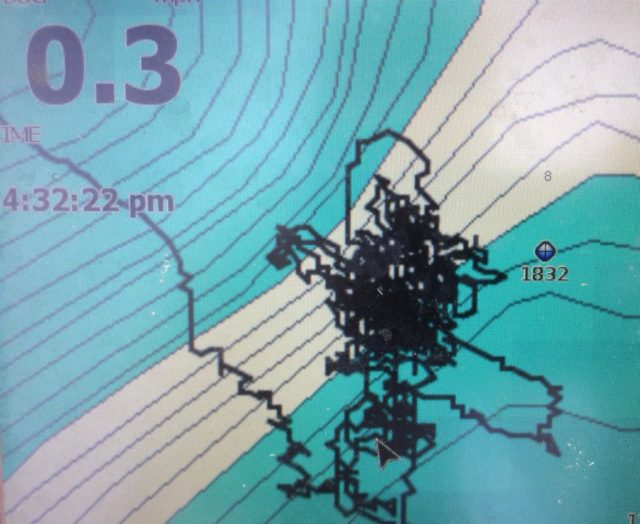
Where you should expect to locate pods of smallmouth, setting up at prior to dark. A total of 20+ fish was captured from this specific area along the deep edges of a shallow bar.
6:00 pm –
The powers of sunlight and heat are slowly relenting. Now’s the time of day you should be within the vicinity of your newfound spots, and high percentage locations. If the hot spots you found are shallow near main-lake coves, rock bars, sand flats, rocky shoals, a small point, or some type of unique shallow mid-lake or near-shore location, always start fishing along their deepest sections, away from their shallowest tops. As the sun gradually sets, slowly move in. Smallmouth will be doing the same.
The best spots are smaller, isolated spots. They can be found in near-shore and mid-lake areas. Large expansive areas such as a huge flat or reef are otherwise too unproductive, requiring lots of distance to cover and leads to inefficient fishing. Only fish these areas if they have “spot on the spot” types of features and obvious habitat.
Nighttime feeding locations will vary according to the prey species populating the lake. Smallmouth will go where the food is. On my lakes, it’s crayfish. They are scavenging and feeding on shallow rock shoals, along the tops of shallow rock bars, or in submerged wood. Smallmouth will undoubtedly be in those locations also. Habitat is the bonus, but does equate to a very high percentage location used by prey and predator. On many of Wisconsin’s smallmouth lakes, rusty crayfish encompass more than 50% of a smallmouth’s diet.
Because this after dark summer pattern is influenced by crayfish movements and location, the mid-depth edges of structure in 15 to 8 ft. depths are the most ideal starting points. These edges will serve as routes for smallmouth when they return shallow to feed at peak hour. Between now and sunset, smallmouth can move into the shallows at any time.
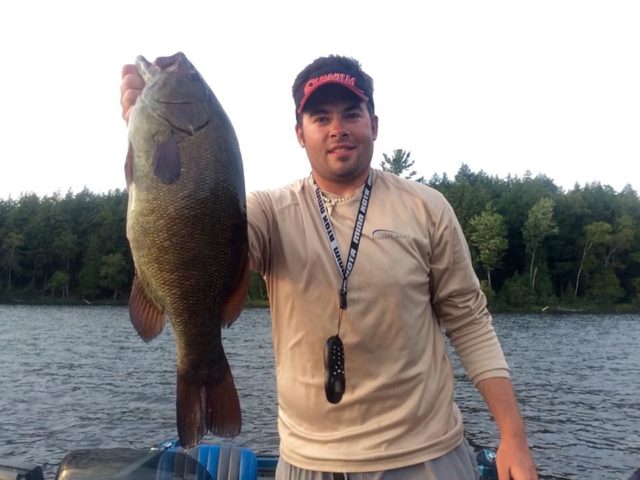
During sunset, big smallmouth like this 5 pounder will be returning to the shallows to feed on crayfish. Earlier in the day, a fish of this caliber might have been holding deep and mostly uncatchable.
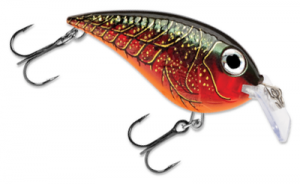
Rapala Cranking Rap (05)
I begin the evening fishing along the edges of habitat-rich shorelines, shallow rock bars, and other near-shore locations that are known crayfish and smallmouth feeding grounds. Rock, boulders, and wood will add to their luxury. I meticulously cover the deeper edges first by power cranking, fan-casting with loud rattling, craw patterned squarebill crankbaits. As my most successful nighttime smallmouth lures to date, I have found these crankbaits to possess the loudest rattles and widest, most compact vibration. Both properties are critical to triggering strikes at night. I continue with this crankbait program well beyond sunset as long as bass continue reacting to it.
If crankbaits aren’t taking names of bass yet, fish slower and more meticulous. A jig bite can be the ticket. While light level will still be good, weedless or hook exposed jig inserted tubes such as a Strike King Coffee tube will catch numbers. Meanwhile skirted twin tails like a 5” Chompers Hula Grub rigged on a ¼ oz. to 3/8 oz. football head could catch bigger fish. The same can be said too for a traditional skirted football jig and craw trailer dragged along bottom.
Snags will be an inconvenience after dark, but if you’re getting steady pickups throughout the evening, you’ll find yourself jigging and dragging plastics most often throughout the night.
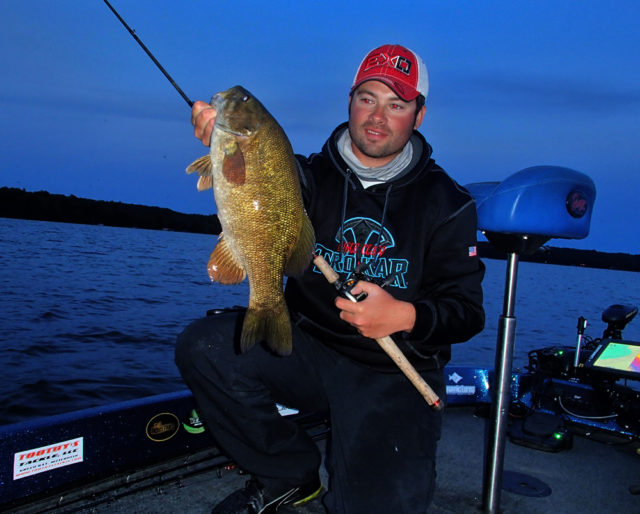
If fishing unfamiliar water, always map and chart it first prior to fishing. You will be able to find productive spots you will re-visit later on at night. This quality 4 pounder was taken from a lake I had fished for the first time ever that night. The catch would not have been possible without the mapping I had done earlier in the afternoon.
8:00 pm –
By now, smallmouth have slowly progressed towards the shallows where they can be feeding in depths as shallow as 5 ft. or less. The remaining daylight is now precious. Bites will come in rapid succession. As your efficient, convenient milkrun has been established, you must run and gun from spot to spot, wasting no time in between. Thoroughly fish every next-location waypointed high percentage spot you visited and charted earlier. Give each major area at least 15 minutes of time. Continue fishing with the same crankbait and jig program highlighted above. If the bite settles, try waking them up with a loud topwater before deciding to move on.
The shallow tops of bars will now become the focal point of your fishing. Rock bars, humps, and shoals are some of the best locations I’ve found for sunset and after dark fishing. The tops of them all will usually have the sexiest elements of the structure which could be the largest rock or boulders. Smallmouth often gravitate to them in low light to use as an ambush point. They will also hold on these locations throughout the night, using them as resting areas for the night too. Over the years, I have experienced nights where I’ve been able to pull up to 20 to 30 bass off of these small structures. When that happens, the spot is loaded with food and the fish pile in like it was spring all over again.
A topwater fished over the tops of shallow bars will catch the most fish. The sights of explosions and strikes will be something to behold.
Topwaters are my favorites for this hour. They’ll perform best on nights of high humidity and without any wind. Keep a close eye on surface activity or insect hatches, as they are hard to beat when surface activity is prevalent.
I have gotten best after-dark results with the Rapala X-Rap Pop. Fish will hear it, see it, and strike it from great distances. What separates this topwater from others is the amount of surface water it pushes, and the loud obnoxious plopping sound you can get it to produce. Every mid summer, it engages some of the largest smallmouth in the system to strike and connect. The more obnoxious and loud your pops, the more strikes it triggers.
The X-Rap Pop comes with two strong VMC trebles. In order to keep fish pinned with the most minimal of hooksets, I strongly encourage immediately swapping only the front hook in favor of a larger size Trokar Tk300 round bend treble hook. A slightly oversize hook will help you connect with more fish and reduce the number of misses from fish that failed to grab it.
During prime time, always reciprocate between a crankbait, jig, and topwater. Unless smallmouth are locked in on a specific presentation, their mood and strike styles will tell you when to make adjustments and switch lures entirely. – A.R.
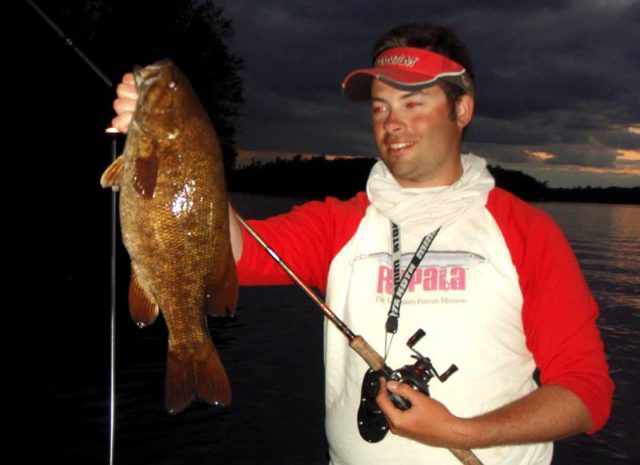
During prime time, always reciprocate between a crankbait, jig, and topwater. Unless smallmouth are locked in on a specific presentation, their mood and strike styles will tell you when to make adjustments and switch lures.
10:00 pm –
The best fishing and peak feeding of the night has now taken place. By now a bug hatch or two could be starting. Some nights, the bite concludes within an hour after sunset. While other nights, the same flurry of action could continue deeper into the night. Keep your boat and casting decks well lit, and clean from clutter and excess hooks. Always keep a powerful LED head lamp handy to aid when landing a fish and during hook removal.
Most smallmouth will remain on the tops and along the shallower edges of the shallow structures. Some fish will continue to feed, while others might hit the hay and get themselves ready for the next day of heavy feeding. Keep fishing the shallowest, most structure filled areas as fish will continue moving on and off of them. It might take 20 casts or more in one direction before you get your first bite.
Continue fishing with crankbaits and topwaters as they produce the greatest noise, vibration, and reaction. Shorten your casts by half the distance to avoid snags and potential backlashes. If neither power option works, I’ve found that a bigger jig and larger craw profile gets the most attention.
Smallmouth have very good night vision and they can see and sense the jig on the bottom well into the night. Last season, my best post-sunset bait was a 4” Gene Larew Biffle Bug rigged with a 3/8 oz. Freedom Tackle Corp. swinging head jig paired with a 3/0 Trokar TK110. The fish up north had yet to see this type of a simple jig combination before. Rigged on a 7’ 2” MH baitcaster spooled with 20 lb. Cortland Masterbraid and a 4 ft. section of 12 lb. Seaguar fluorocarbon leader, the weedless jig scurries along bottom, maintaining bottom contact 100% of the time. When in motion, the Biffle Bug’s slick action and moving appendages is what makes the package work.
When you get struck after dark, hang on tight. Fish will strike jigs with much greater force at night, unable to realize they’ve been hooked.
Post-Midnight –
There will be some nights you might keep catching bass well past midnight. Overdo it, or if you have to wake up early for the next day, you might become a zombie the next morning.
Around this time of night is when you must be most careful for the sake of navigation and on the water safety. GPS is the most essential tool in your boat, as without it you might not return to the boat landing. I tend to camp out on my nearest spots to the boat landing in case I make a spur of the moment, impulse decision to pack it up for the night and leave the lake. If you must navigate from spot to spot, only do so at slower idle speeds to avoid collisions with loons, floating docks and buoys, or accidents with poorly lit boats. Always keep your lights on, and use a high-beam spot light to aid navigation if you are traveling near shore.
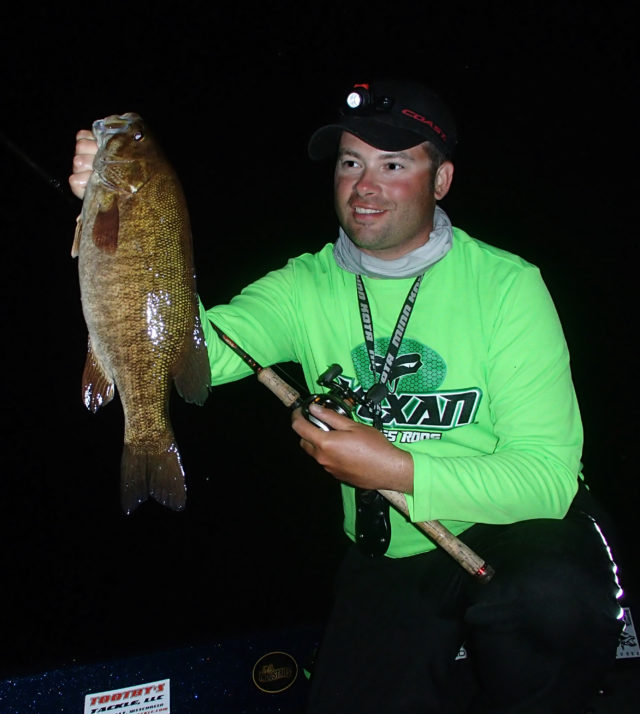
The strong bite may continue well past sunset. Never leave fish in order to find fish. It’s important to camp on spots because bass will be moving in and out often. You will catch most bass by doing that.
Most nights I’m off the water after 10 pm, but some nights the bite could be on fire and smallmouth won’t know when to stop. This activity could be influenced by an overabundance of crayfish, a large insect hatch, and high humidity levels. If fishing continues to remain productive, keep fishing the same program as you did a few hours ago during the 10 pm window. Only remember to fish slower. In addition to the smallmouth you catch, there might be some walleye joining the event too.
This pattern is one of the rare cases where a summer heat wave actually improves fishing. If seeking trophy smallmouth, the summer set-up is now a well tested strategy to try.
Some years, the summer smallmouth set-up is one of the most effective, guaranteed big fish bites of the season. Summers that have been colder, rainy, windy, and less humid have resulted in more difficult fishing and delivered inconsistent conditions for the phase to completely establish.
Learn to track and anticipate smallmouth movements from daytime to nighttime. As the earth rotates around the sun, and is most noticeable in the hours prior and after sunset, smallmouth will react to these changes in a positive manner and transition from deep back to shallow. To catch them, base your fishing, boat positioning, and depths according to their moods and location during that hour and shortening of daylight.
Like clockwork, the presence of smallmouth and their heavy feeding in shallow locations can be expected during every summer night of stable weather. As the sun sets, all other boats pack it up for the night. My game only starts then.


